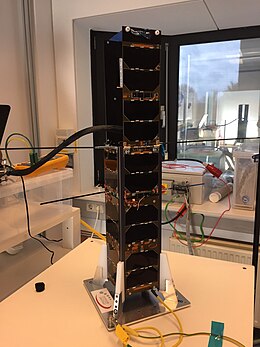
The Very Large Telescope (VLT) is an astronomical facility operated since 1998 by the European Southern Observatory, located on Cerro Paranal in the Atacama Desert of northern Chile. It consists of four individual telescopes, each equipped with a primary mirror that measures 8.2 meters in diameter. These optical telescopes, named Antu, Kueyen, Melipal, and Yepun, are generally used separately but can be combined to achieve a very high angular resolution. The VLT array is also complemented by four movable Auxiliary Telescopes (ATs) with 1.8-meter apertures.

The European Organisation for Astronomical Research in the Southern Hemisphere, commonly referred to as the European Southern Observatory (ESO), is an intergovernmental research organisation made up of 16 member states for ground-based astronomy. Created in 1962, ESO has provided astronomers with state-of-the-art research facilities and access to the southern sky. The organisation employs over 750 staff members and receives annual member state contributions of approximately €162 million. Its observatories are located in northern Chile.

Pictor is a constellation in the Southern Celestial Hemisphere, located between the star Canopus and the Large Magellanic Cloud. Its name is Latin for painter, and is an abbreviation of the older name Equuleus Pictoris. Normally represented as an easel, Pictor was named by Abbé Nicolas-Louis de Lacaille in the 18th century. The constellation's brightest star is Alpha Pictoris, a white main-sequence star around 97 light-years away from Earth. Pictor also hosts RR Pictoris, a cataclysmic variable star system that flared up as a nova, reaching apparent (visual) magnitude 1.2 in 1925 before fading into obscurity.

A planetary system is a set of gravitationally bound non-stellar bodies in or out of orbit around a star or star system. Generally speaking, systems with one or more planets constitute a planetary system, although such systems may also consist of bodies such as dwarf planets, asteroids, natural satellites, meteoroids, comets, planetesimals and circumstellar disks. For example, the Sun together with the planetary system revolving around it, including Earth, form the Solar System. The term exoplanetary system is sometimes used in reference to other planetary systems.
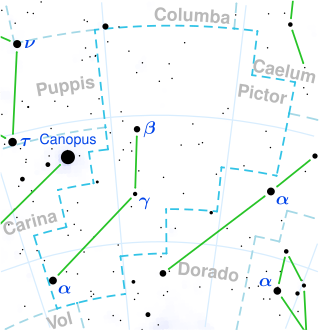
Beta Pictoris is the second brightest star in the constellation Pictor. It is located 63.4 light-years (19.4 pc) from the Solar System, and is 1.75 times as massive and 8.7 times as luminous as the Sun. The Beta Pictoris system is very young, only 20 to 26 million years old, although it is already in the main sequence stage of its evolution. Beta Pictoris is the title member of the Beta Pictoris moving group, an association of young stars which share the same motion through space and have the same age.

The High Accuracy Radial Velocity Planet Searcher (HARPS) is a high-precision echelle planet-finding spectrograph installed in 2002 on the ESO's 3.6m telescope at La Silla Observatory in Chile. The first light was achieved in February 2003. HARPS has discovered over 130 exoplanets to date, with the first one in 2004, making it the most successful planet finder behind the Kepler space telescope. It is a second-generation radial-velocity spectrograph, based on experience with the ELODIE and CORALIE instruments.
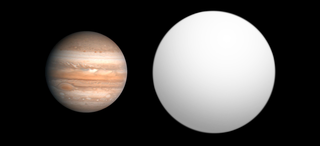
2M1207b is a planetary-mass object orbiting the brown dwarf 2M1207, in the constellation Centaurus, approximately 170 light-years from Earth. It is one of the first candidate exoplanets to be directly observed. It was discovered in April 2004 by the Very Large Telescope (VLT) at the Paranal Observatory in Chile by a team from the European Southern Observatory led by Gaël Chauvin. It is believed to be from 5 to 6 times the mass of Jupiter and may orbit 2M1207 at a distance roughly as far from the brown dwarf as Pluto is from the Sun.

WASP or Wide Angle Search for Planets is an international consortium of several academic organisations performing an ultra-wide angle search for exoplanets using transit photometry. The array of robotic telescopes aims to survey the entire sky, simultaneously monitoring many thousands of stars at an apparent visual magnitude from about 7 to 13.
{{Infobox scientist |name =Daniel Apai |image = |image_size = |caption = Prof. Daniel Apai |birth_name = |birth_date =January 11, 1977 |birth_place =Szeged, Hungary |nationality =American, Hungarian |field =Astrophysics, Astrobiology, Planetary Sciences, Space Telescopes |work_institution =The University of Arizona |alma_mater =Szeged University (Diploma) / University of Heidelberg (PhD) |doctoral_advisor =Thomas Henning |doctoral_students= Benjamin V. Rackham, Yifan Zhou, Kevin Wagner, Ben Wei Peng Lew, Alex Bixel, [[Jamie Dietrich],[Rachael Amaro]] |known_for = extrasolar planet searches and characterization, astrobiology |prizes = AAAS Fellow }}

Beta Pictoris b (abbreviated as β Pic b) is an exoplanet orbiting the young debris disk A-type main sequence star Beta Pictoris located approximately 63 light-years (19.4 parsecs, or 6×1014 km) away from Earth in the constellation of Pictor. It has a mass around 13 Jupiter masses and a radius around 46% larger than Jupiter's. It orbits at 9 AU from Beta Pictoris, which is about 3.5 times farther than the orbit of Beta Pictoris c. It orbits close to the plane of the debris disk orbiting the star, with a low eccentricity and a period of 20–21 years.
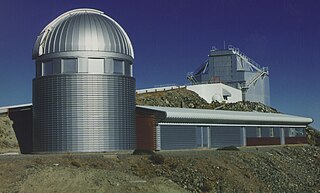
Leonhard Euler Telescope, or the Swiss EULER Telescope, is a national, fully automatic 1.2-metre (47 in) reflecting telescope, built and operated by the Geneva Observatory. It is located at an altitude of 2,375 m (7,792 ft) at ESO's La Silla Observatory site in the Chilean Norte Chico region, about 460 kilometers north of Santiago de Chile. The telescope, which saw its first light on 12 April 1998, is named after Swiss mathematician Leonhard Paul Euler.

CoRoT-9b is an exoplanet orbiting the star CoRoT-9, approximately 1500 light years away in the constellation Serpens. CoRoT-9b's distance of nearest approach to its parent star of approximately 0.36 AU was the largest of all known transiting planets at the time of its discovery, with an orbital period of 95 days. The transit of this planet lasts 8 hours. The planet is at a distance from its star where there is a strong increase in albedo as the temperature decreases, because of the condensation of reflective water clouds in the atmosphere. This suggests its atmosphere may be locked into one of two states: a cloudless state with temperatures between 380 K and 430 K, or covered in water clouds with a temperature in the range 250 K to 290 K.
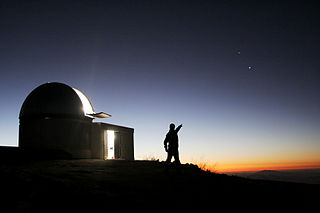
The Transiting Planets and Planetesimals Small Telescope (TRAPPIST) is the corporate name for a pair of Belgian optic robotic telescopes. TRAPPIST–South, which is situated high in the Chilean mountains at ESO's La Silla Observatory, came online in 2010, and TRAPPIST–North situated at the Oukaïmeden Observatory in the Atlas Mountains in Morocco, came online in 2016.
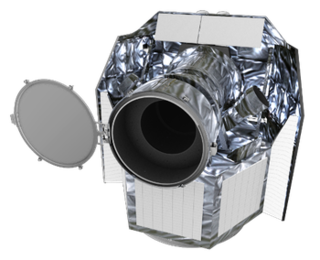
CHEOPS is a European space telescope. Its objective is to determine the size of known extrasolar planets, which will allow the estimation of their mass, density, composition and their formation. Launched on 18 December 2019, it is the first Small-class mission in ESA's Cosmic Vision science programme.
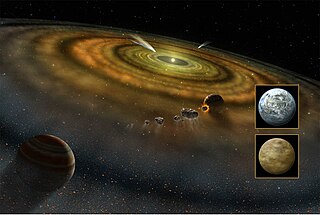
An exocomet, or extrasolar comet, is a comet outside the Solar System, which includes rogue comets and comets that orbit stars other than the Sun. The first exocomets were detected in 1987 around Beta Pictoris, a very young A-type main-sequence star. There are now a total of 27 stars around which exocomets have been observed or suspected.

The Next-Generation Transit Survey (NGTS) is a ground-based robotic search for exoplanets. The facility is located at Paranal Observatory in the Atacama desert in northern Chile, about 2 km from ESO's Very Large Telescope and 0.5 km from the VISTA Survey Telescope. Science operations began in early 2015. The astronomical survey is managed by a consortium of seven European universities and other academic institutions from Chile, Germany, Switzerland, and the United Kingdom. Prototypes of the array were tested in 2009 and 2010 on La Palma, and from 2012 to 2014 at Geneva Observatory.

Spectro-Polarimetric High-contrast Exoplanet REsearch (VLT-SPHERE) is an adaptive optics system and coronagraphic facility at the Very Large Telescope (VLT). It provides direct imaging as well as spectroscopic and polarimetric characterization of exoplanet systems. The instrument operates in the visible and near infrared, achieving exquisite image quality and contrast over a small field of view around bright targets.

ASTERIA was a miniaturized space telescope technology demonstration and opportunistic science mission to conduct astrophysical measurements using a CubeSat. It was designed in collaboration between the Massachusetts Institute of Technology (MIT) and NASA's Jet Propulsion Laboratory. ASTERIA was the first JPL-built CubeSat to have been successfully operated in space. Originally envisioned as a project for training early career scientists and engineers, ASTERIA's technical goal was to achieve arcsecond-level line-of-sight pointing error and highly stable focal plane temperature control. These technologies are important for precision photometry, i.e., the measurement of stellar brightness over time. Precision photometry, in turn, provides a way to study stellar activity, transiting exoplanets, and other astrophysical phenomena.
Anne-Marie Lagrange, born March 12, 1962 in the Rhône-Alpes region of France, is a French astrophysicist. Lagrange's work focuses on the research and study of extrasolar planetary systems. Lagrange is the holder of numerous scientific awards and honorary decorations, including Knight of the Legion of Honour and is a member of the French Academy of Sciences since 2013.
Beta Pictoris c is the second exoplanet discovered orbiting the young star Beta Pictoris, located approximately 63 light-years away from Earth in the constellation of Pictor. Its mass is around nine times that of Jupiter, and it orbits at around 2.7 astronomical units (AU) from Beta Pictoris, about 3.5 times closer to its parent star than Beta Pictoris b. It has an orbital period of 1,200 days. The orbit of Beta Pictoris c is moderately eccentric, with an eccentricity of 0.24.
